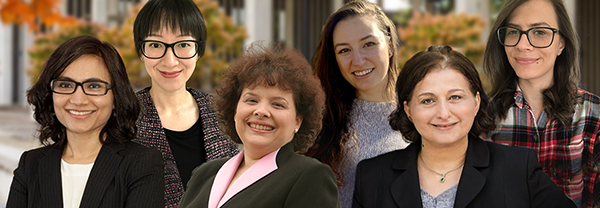A Student-Faculty Team Weighs Effective COVID-19 Messaging to Those with Limited English Proficiency
ALBANY, N.Y. (March 25, 2021) — Rukhsana Ahmed, associate professor and chair in Communication, noted last year that while public health campaigns have proved generally effective in enhancing public health awareness and protection against COVID-19, scant evidence existed on their efficacy when dealing with Limited English Proficient (LEP) individuals.
Her project proposal to work with UAlbany grad students to assess the effectiveness of YouTube videos carrying this messaging so impressed SUNY officials that “Innovative Health Communication Strategy to Combat COVID-19 Health Disparities” was approved in December for seed funding from the SUNY Prepare Innovation and Internship Program.
“Consuming COVID-19 prevention information and translating it into behavior change among LEP groups requires linguistic and cultural tailoring of messages,” said Ahmed. “Each of the four chosen COVID-19 prevention videos was translated in the preferred language of the groups we surveyed — Arabic, Bangla, Chinese and Spanish.
“Such health communication videos can allow LEP groups to address communication inequality by

accessing, processing and acting on information during the pandemic that is linguistically and culturally relevant, which unfortunately is not always the case. Our project team includes native speakers of each LEP population under study, which is an asset that allows us to be sensitive to the linguistic and cultural nuances.”
With Ahmed as principal investigator (PI), the project includes Co-PIs Jeanette Altarriba, professor of Psychology and dean of the College of Arts and Sciences and Dina Refki, Rockefeller College clinical associate professor and executive director of the college’s Center for Women in Government & Civil Society and three student intern research assistants: Erting Sa, PhD candidate and lecturer in Communication; Mary Avery, PhD candidate and lecturer in Psychology; and Sana Abdelkarim, PhD candidate in Public Affairs & Policy.
The UAlbany trio is now evaluating the potential of the videos as a low-cost innovative health communication strategy to influence user knowledge and attitude, thereby addressing communication inequality among these groups and beyond. The project runs through May 31, with the students delivering presentations on the project’s progress at the April 22-23 SUNY Student Success Summit.
Data are still being accumulated from on-line surveys, but, said Refki, “we are seeing that health messages must be culturally and linguistically adapted to the communities and must be framed in ways that connect with people's deeply held belief systems in order to be effective.”
Noted Altarriba: “Our findings will likely help providers to effectively communicate vaccination messages that will be critical to stakeholders in addressing and eliminating vaccine hesitancy.”
Each of the language groups surveyed is comprised of 50 individuals identified as LEP speakers. “We are also getting ready to conduct one-on-one interviews with five LEP individuals within each of the four communities,” said Ahmed.
The students who will be conducting the interviews have already been impressed at the way the project has been received by the LEP groups and their community leaders. Among the goals of the SUNY initiative, which supplied seed funding to projects on seven SUNY campuses, was to provide such valuable applied learning and research experiences to outstanding students.
“I have been pleasantly surprised by the hard work and willingness that our community partners have demonstrated,” said Avery. “These communities are sometimes hesitant to engage with researchers and medical personnel, and understandably so, as their needs are often overlooked at a systemic level. However, our community leaders have been incredibly receptive and engaged, and offered their own insight on the issues they face as a community in the pandemic. In that sense the project has been an even greater learning experience — we have gained much from partnering with them.”
“I personally am surprised by how many new techniques I learned during this process,” said Sa. “For example, not only have I learned how to utilize the survey software, Qualtrics, to translate our English survey into targeted languages but I also managed to embed the video in the survey page so there will be no extra steps for us and our participants.”
“Our community partners show care and compassion for their clients and ask questions about how the research would help their community,” said Abdelkarim. “I find this truly humbling. In many cases, research is often disconnected from the community and the public. This is an opportunity for me, at least as a young public policy researcher, to think about where the public fits in my research and how my work can benefit them.”




